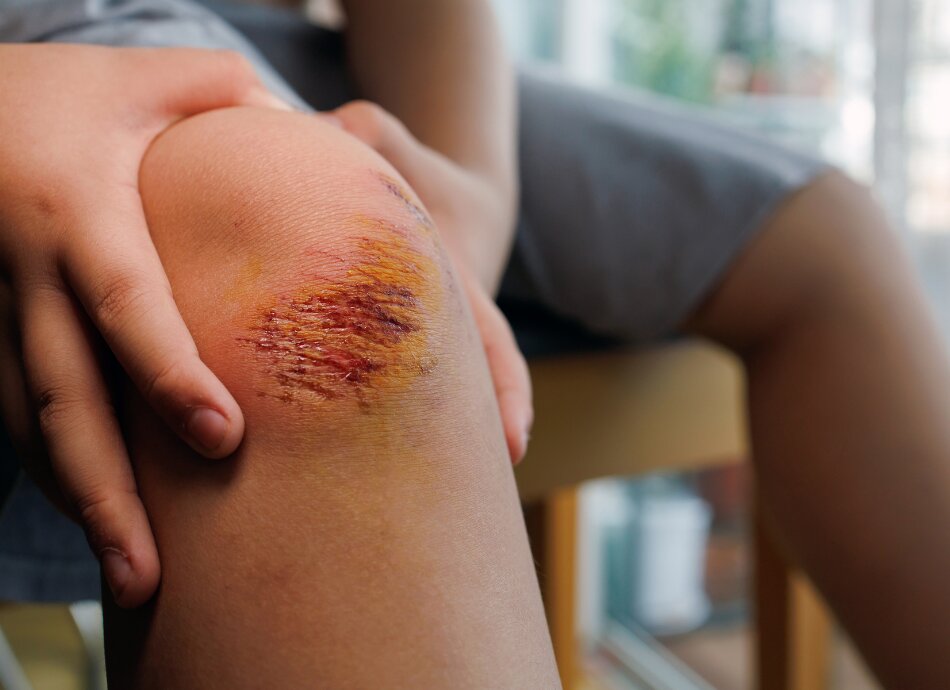Cuts and grazes
Key points about cuts and grazes
- A cut is when your skin is cut or torn.
- A graze is when the surface of your skin is scraped or rubbed away.
- Cuts and grazes are common injuries that can usually be treated at home.
- Deeper cuts (called lacerations) might need stitches by a nurse or doctor.

A cut is when your skin is cut or torn, while a graze is when the surface of your skin is scraped or rubbed away.
Cuts and grazes are common injuries that can usually be treated at home, although deep cuts (called lacerations) might need stitching up by a nurse or doctor.
You can usually treat a cut or graze yourself by stopping any bleeding, carefully cleaning the wound and covering it with a plaster or bandage. See the section on how to clean and dress a wound below.
- Check the wound and make sure there's nothing stuck in it.
- Put pressure on the area for several minutes using a clean, folded cloth, eg, a bandage, towel or handkerchief.
- If the cut is on your hand or arm, raise it above your head to help reduce the flow of blood.
- If the injury is to a lower limb, lie down and raise the affected area above the level of your heart.
- When the bleeding has stopped, firmly wrap a new bandage over the cut. Check it after 10 minutes or so if you need to clean the wound.
Apps reviewed by Healthify
You may find it useful to look at some First aid and emergency apps.
- Wait till the wound has stopped bleeding (see how to stop bleeding above).
- Wash your hands well with soap and water.
- Clean the wound with tap water or use sterile saline solution if there is some in your first aid kit. Try to gently remove dirt or gravel if it's a graze.
- Gently pat the area dry with a clean cloth, towel or gauze swab.
- Apply antiseptic cream like Savlon or Betadine (if you have some) if the wound needs cleaning. However, most small cuts and grazes will heal well without this.
- Cover with a non-stick dressing and keep dry for at least 24 hours if possible.
- Replace the dressing if it gets wet or dirty.
- Check whether you need a tetanus injection if it is more than 10 years since your last injection, or 5 years if the wound is dirty and deep.
See your doctor, nurse or urgent care clinic if:
- The cut or graze is swollen, red, has pus coming out of it, or the pain is worsening.
- Red streaks develop around the wound.
- The cut is deep (stab wound) or larger than about 5cm.
- You feel unwell or have a high temperature.
- The wound is contaminated with dirt or poo (faeces) as you might need a booster injection to prevent tetanus.
- The wound hasn't healed after 2 weeks.
Call 111 if:
- You have a cut or wound and can't stop the bleeding.
- The blood comes out in spurts, is bright red and hard to stop.
- You lose feeling near the wound.
- You have a bad cut on your face or the palm of your hand.
- The cut is very large or deep.
- There is something stuck in it, eg, a piece of glass.
Cuts, scrapes and wounds first aid(external link) Health New Zealand | Te Whatu Ora
Cuts and grazes(external link) NHS, UK
Apps
Brochures
Cuts, scratches and grazes (external link)Health Literacy, NZ
Healthy skin(external link) Health Literacy, NZ
References
- Cuts, scrapes and wounds first aid(external link) Health New Zealand | Te Whatu Ora
- Cuts and grazes(external link) NHS, UK, 2022
- Topical antibiotics for skin infections – when are they appropriate?(external link) BPAC, NZ, 2017
What prescribers need to know
- In primary care, many skin infections are relatively minor and don't need to be treated with antibiotics. They will generally improve with good skin hygiene measures, eg, cleaning and covering the wound. Management should focus on good skin hygiene measures and a trial of a topical antiseptic (rather than a topical antibiotic).
- Don't prescribe topical antibiotics for patients with infected eczema, for wound management, for other skin infections or first-line for impetigo. If antibiotic treatment is required, prescribe an oral medicine.
- Topical antibiotics may be appropriate as a second-line option for patients with areas of localised impetigo, if first-line management with hygiene measures and topical antiseptics has not resolved the lesions or for Staphylococcus aureus nasal decolonisation.
- If a topical antibiotic is prescribed, patients should be instructed to use it for no longer than 7 days. The practice of saving an unfinished tube as a first-aid measure for household members should be strongly discouraged.
References:
- Topical antibiotics for skin infections – when are they appropriate?(external link) BPAC, NZ, 2017
- Managing skin infections in Māori and Pacific families(external link) BPJ Article, August 2012
- Skin infections in children – talking points for health professionals – prevention(external link) Health Literacy NZ
- Talking points for 'Looking after your child's skin and treating skin infections (external link)Health Literacy NZ
- Skin infections lesson plans for years 2 and 3(external link) Health Literacy NZ
- Lesson plans for years 5 and 6(external link) Health Literacy NZ
Apps
Credits: Healthify editorial team. Healthify is brought to you by Health Navigator Charitable Trust.
Reviewed by: Dr Janine Bycroft, GP, Auckland
Last reviewed:





